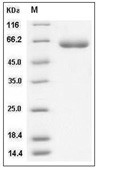- 全部删除
 您的购物车当前为空
您的购物车当前为空
LBP Protein, Human, Recombinant (His)
Lipopolysaccharide binding protein ( LBP ) is a glycoprotein that is synthesized principally by hepatocytes. LBP is a trace plasma protein that binds to the lipid A moiety of bacterial lipopolysaccharides ( LPSs ). LBP binds directly to the outer membrane of Gram-negative bacteria and purified aggregates of extracted endotoxin and catalyzes the delivery of endotoxin to the membrane ( mCD14, GPI-Linked ) and soluble ( sCD14 ) forms of CD14, thereby markedly increasing host cell sensitivity to endotoxin. LBP efficiently catalyzes the transfer of individual molecules of endotoxin to (s)CD14 only when LBP–endotoxin aggregates are formed in the presence of albumin. In the presence of EDTA, LBP binding promotes further disaggregation of endotoxin. LBP binding does not have such drastic effects under more physiological conditions, but may still induce more subtle topological rearrangements of endotoxin.

LBP Protein, Human, Recombinant (His)
| 规格 | 价格 | 库存 | 数量 |
|---|---|---|---|
| 50 μg | ¥ 3,360 | 现货 | |
| 100 μg | ¥ 5,740 | 5日内发货 | |
| 200 μg | ¥ 9,800 | 5日内发货 |
产品信息
| 生物活性 | Activity testing is in progress. It is theoretically active, but we cannot guarantee it. If you require protein activity, we recommend choosing the eukaryotic expression version first. |
| 产品描述 | Lipopolysaccharide binding protein ( LBP ) is a glycoprotein that is synthesized principally by hepatocytes. LBP is a trace plasma protein that binds to the lipid A moiety of bacterial lipopolysaccharides ( LPSs ). LBP binds directly to the outer membrane of Gram-negative bacteria and purified aggregates of extracted endotoxin and catalyzes the delivery of endotoxin to the membrane ( mCD14, GPI-Linked ) and soluble ( sCD14 ) forms of CD14, thereby markedly increasing host cell sensitivity to endotoxin. LBP efficiently catalyzes the transfer of individual molecules of endotoxin to (s)CD14 only when LBP–endotoxin aggregates are formed in the presence of albumin. In the presence of EDTA, LBP binding promotes further disaggregation of endotoxin. LBP binding does not have such drastic effects under more physiological conditions, but may still induce more subtle topological rearrangements of endotoxin. |
| 种属 | Human |
| 表达系统 | HEK293 Cells |
| 标签 | C-His |
| 蛋白编号 | P18428 |
| 别名 | lipopolysaccharide binding protein,BPIFD2 |
| 蛋白构建 | A DNA sequence encoding the human LBP (NP_004130.2) extracellular domain (Met 1-Val 481) was fused with the a polyhistidine tag at the C-terminus. Predicted N terminal: Ala 26 |
| 蛋白纯度 | > 95 % as determined by SDS-PAGE  |
| 分子量 | 52.5 kDa (predicted); 62 kDa (reducing condition, due to glycosylation) |
| 内毒素 | < 1.0 EU/μg of the protein as determined by the LAL method. |
| 缓冲液 | Lyophilized from a solution filtered through a 0.22 μm filter, containing 20 mM Tris, 100 mM NaCl, 0.05 mM EDTA, pH 8.0.Typically, a mixture containing 5% to 8% trehalose, mannitol, and 0.01% Tween 80 is incorporated as a protective agent before lyophilization. |
| 复溶方法 | A Certificate of Analysis (CoA) containing reconstitution instructions is included with the products. Please refer to the CoA for detailed information. |
| 存储 | It is recommended to store recombinant proteins at -20°C to -80°C for future use. Lyophilized powders can be stably stored for over 12 months, while liquid products can be stored for 6-12 months at -80°C. For reconstituted protein solutions, the solution can be stored at -20°C to -80°C for at least 3 months. Please avoid multiple freeze-thaw cycles and store products in aliquots. |
| 运输方式 | In general, Lyophilized powders are shipping with blue ice. |
| 研究背景 | Lipopolysaccharide binding protein ( LBP ) is a glycoprotein that is synthesized principally by hepatocytes. LBP is a trace plasma protein that binds to the lipid A moiety of bacterial lipopolysaccharides ( LPSs ). LBP binds directly to the outer membrane of Gram-negative bacteria and purified aggregates of extracted endotoxin and catalyzes the delivery of endotoxin to the membrane ( mCD14, GPI-Linked ) and soluble ( sCD14 ) forms of CD14, thereby markedly increasing host cell sensitivity to endotoxin. LBP efficiently catalyzes the transfer of individual molecules of endotoxin to (s)CD14 only when LBP–endotoxin aggregates are formed in the presence of albumin. In the presence of EDTA, LBP binding promotes further disaggregation of endotoxin. LBP binding does not have such drastic effects under more physiological conditions, but may still induce more subtle topological rearrangements of endotoxin. |




